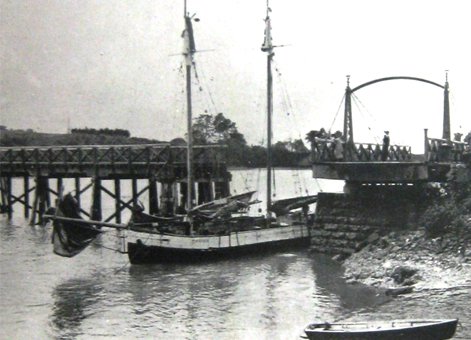William Weaver was born at Beckington, Somerset, England, in May 1828. Educated in England, he was a pupil of Brassey and Peto of Bristol, and from 1846 was trained in the office of Brunel and later RI Ward. He worked on the Great Western Railway and other architectural and engineering projects. Weaver fell into problems with a coal-mining venture that was unprofitable and then travelled to Australia in 1850.

Use a Tamaki River bridge image for thumbnail/cover
Australian career
Weaver started as Foreman of Works in the Sydney Colonial Architect’s office where he was given much of the credit for the design ingenuity of incorporating large timber trusses in the Victoria Bridge at Maitland. He was appointed Colonial Architect following Edmund Blacket’s resignation in late 1854. He designed a new government printing office, completed in the following year, and continued the building of timber bridges across rivers in country areas. After a dispute with the Governor, Weaver resigned as Colonial Architect on 31 March 1856.
He then became New South Wales’ Chief Engineer and won first prize for his Melbourne Post Office design. Political interference was behind Weaver’s decision to leave his job and in 1863 he became engineer for 16 miles of the Richmond to Windsor Railway construction. He was also architect for the Oriental Bank, Sydney School of Arts, and other projects.
It was during his time in Australia that Weaver was elected an Associate Member of the Institution of Civil Engineers (United Kingdom) on 21 January 1857. He was transferred to the class of Member on 4 February 1868.
Auckland’s water supply
Weaver came to New Zealand on 25 April 1864, to take up the position of Auckland Provincial Council’s Engineer-in-Chief.
Auckland was reliant on wells and roof water, so suffered chronic water shortages and disastrous fires in 1858 and 1863. Weaver’s employment coincided with a £500,000 loan being raised for Public Works.
There had been many years of debate and inaction by the Provincial Council about city water supply. In August 1864, Weaver reported on six options for water supply to Auckland. Considerable interest was voiced in a supply from the Nihotupu stream in the Waitakere Ranges, which Weaver recommended could deliver 850,000 gallons per day at a cost of £82,771. By omitting filter beds and service reservoirs he suggested the scheme could be built for £67,019.
Weaver was responsible for the first water supply piped from the Domain springs in 1866 at a cost of £3,207. However, financial constraints limited the choice of water supply to cheaper and less desirable options until 1902 when the Nihotupu scheme recommended by Weaver was eventually constructed and brought into service.
Auckland transportation projects
Transportation by sea and land was vital for the rapidly growing town of Auckland in the 1860s. In November 1864, Weaver prepared plans for the improvement of Auckland's two harbours including the erection of new wharves, extensions to existing piers and a breakwater. The works were carried out at a cost of £57,500.
A railway from Auckland to Onehunga, and south to the Waikato, had been proposed. Weaver investigated various alternative routes into Auckland. Against Weaver’s advice, contracts were let to contractors without sufficient resources and major difficulties and expenses resulted.
A commission of enquiry in 1866, including Weaver, found documents had been inadequately inspected before contracts were let and the whole work was in a very unsatisfactory state. The work was stopped until 1872 and the first passenger train operated in December 1873.
Other projects included designing and erecting a bridge over the Tamaki River, 576-feet-long and 21-feet-broad at a cost of £17,025. In 1866 Weaver also provided a cost estimate for a 25-mile-long canal linking the Waitemata and Kaipara harbours. However, he recommended a railway of 17 miles instead, which he estimated to cost £51,000.
A busy public servant
Between 1864 and 1867, he carried out works of all kinds to the value of £230,000 at a cost for design and supervision of three per cent. He was always under pressure and often criticised by members of the Provincial Council.
Weaver’s report to the Council dated 6 January 1866 states:
"Your Honour will be aware of the very considerable portion of every day which is necessarily occupied in personal communication with parties having business with the office, leaving little time for the conduct of the general business of the department, and less still for the consideration and design of works of importance and their personal inspection by myself. Some idea of the amount of clerical work may be formed by the following items of a portion of it during the past year.
Number of letters written – 756
Number of letters received – 564
Number of letters referred to me from the Superintendent’s office and reported on – 554."
At the time Weaver’s staff comprised one assistant engineer, an inspector of roads, a clerk/draftsman and a clerk/accountant.
In 1867, owing to financial stringency, his salary was reduced from £800 per annum and he was allowed to engage in private practice. In this capacity he made the first survey for a dry dock at Auckland. In October 1866, in addition to his other duties, he took over the control of telegraph communications from the military authorities.
In February 1868 he resigned as Engineer in Chief of the Provincial Council to become Telegraph Engineer for New Zealand. However he only held the position for a few months before leaving for Australia.
Weaver died suddenly of "apoplexy" at Geelong, Victoria, Australia on 18 December 1868.
Find out more
Source
Frederick Furkert, Early New Zealand Engineers (Wellington: Reed, 1953) p.288.
Further reading
Cyril W Firth, A Century of Water Supply for Auckland, New Zealand(Auckland: Auckland Regional Authority, 1967).
David Lowe, Tracks Across the Isthmus (Henderson: Lodestar Press, circa1974).
